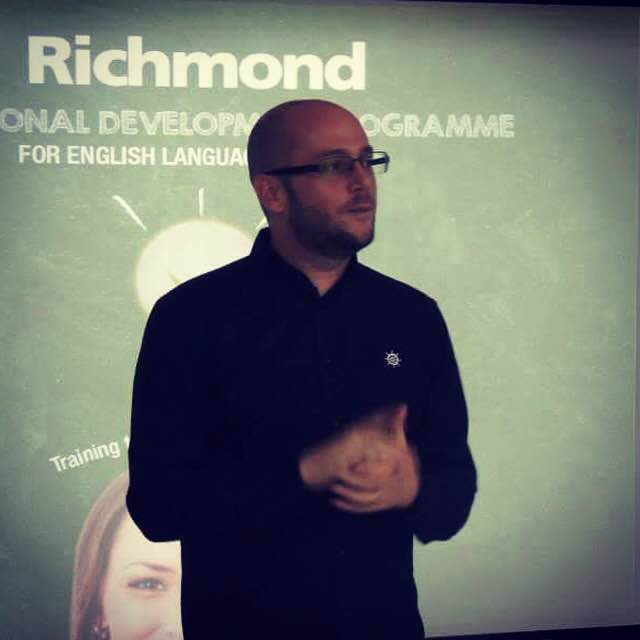Revisiting ELT Mantras #5: Grade the task, not the text
10 years ago I was teaching in in a school in central London. At that time the internet as a teaching resource was just beginning to take off, and while I and many of my peers were starting to get to grips with how to get the most out of it, there was always the trusty Metro. Metro was (and still is) a popular free newspaper which is distributed on the London underground. It has broad appeal both due to the nature of it’s articles and the range of topics covered. None of the texts are really too taxing which makes it perfect for the bleary-eyed morning commute.
Newspaper colour by Jon S CC BY 2.0
A typical noughties classroomIt also makes it perfect as a resource for EFL teachers and their students. Not only because of the way it’s written and the topics it covers, but also because it’s a free source of up-to-date authentic texts, and using authentic texts in class brings many benefits. Firstly, reading authentic texts may actually be a ‘very real and tangible goal’ for many learners (Sanderson, 1999:3), and so it makes sense to give them real practice in the controlled environment of the classroom. It can also be really motivating for learners to read a text which they know is real (Lightbrown & Spada, 2006). As a language learning resource, it can provide exposure to idiomatic language, ‘rarer’ words and complex, natural written syntax (Thornbury, 2005:107). And it’s not just language features, using authentic texts can also give learners valuable exposure to different features of a particular genre, or different genres themselves (Roberts, 2014).
But what do we do about the problem of comprehension? Of course there are many benefits to using authentic texts, but is there much point if the language is so complex that learners won’t be able to understand most of it? There’s quite a bit of debate as to how useful it is to expose learners to texts in which they don’t know a lot of the language, but many believe it’s useful. Lightbrown & Spada (2006) argue,
Learners who successfully acquire English outside classrooms certainly are exposed to a variety of forms and structures which they have not mastered.
When I was first training up as a teacher, one of the Mantras I was taught in order to tackle this question was Grade the task, not the text. The idea being that in order to give learners the opportunity to work with authentic texts, even at lower levels, you design a comprehension task that they’ll be able to successfully complete, without necessarily having to understand all the language in the text.
Personally, this idea has always sat rather uncomfortably with me, and I’ll be the first to admit that I’ve sometimes found myself giving learners fairly menial and pointless tasks just to allow them to interact with an authentic text. Thornbury (2005:108) gives an example of an authentic text used in a coursebook with a comprehension exercise which doesn’t even require looking at the main body of the text in order to complete, and goes on to say,
This raises the question as to whether the strategy of grading the task, not the text may not sometimes be taken too far, resulting in tasks that are trivial and texts that are redundant.
Non alcoholic beer by jrsnchzhrs CC BY ND 2.0
Something else I don’t really see the point ofSo, if authentic texts can sometimes be too difficult, and graded texts don’t bring the benefits outlined above, then what are we to do? Rachael Roberts, on her elt-resourceful blog, makes a very convincing case for a middle way. As a very experienced coursebook writer herself, the authentic v graded question is one she’s always had to face when deciding whether to select or write texts for her books. In her post, she describes how she’ll study features of the genre of her target text, then write her own texts within this framework.
As teachers, we can also adapt authentic texts slightly in order to make them more accessible to learners. One really useful online tool I use when I write texts myself is the Online Graded Text Editor. This is a free online resource into which you can paste an authentic text, select the level, and then it highlights features of language above the level, which you can then decide whether to keep or substitute, depending on your specific learners. This way, you’re making a valuable compromise I think in which your learners are still reaping many of the benefits of exposure to authentic texts, but are also able to do comprehension tasks which are meaningful at the same time.
References
Lightbrown, P. and Spada, N. 2006 How Languages are Learned Oxford University Press
Roberts, R. 2014 Authentic or graded? Is there a middle way? in elt-resourceful (retrieved 13th June 2014 from https://elt-resourceful.com/2014/02/27/authentic-or-graded-is-there-a-middle-way/ )
Sanderson, P. 1999 Using Newspapers in the Classroom Cambridge University Press
Thornbury, S. 2005 Beyond the Sentence: Introducing discourse analysis Macmillan







